SECTION A (40 marks)
Answer all questions in this section in the spaces provided.
- The diagram below illustrates a blood capillary surrounding a structure for gaseous exchange in human beings.
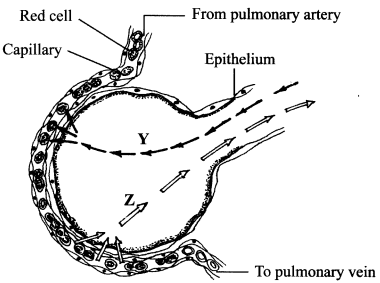
- Name the gaseous exchange structure. (1 mark)
- Identify the gases labelled Y and Z.
Y (1 mark)
Z (1 mark) - How does the gas labelled Y reach the inside of the blood capillary? (3 marks)
- How does cigarette smoking lead to lung cancer? (2 marks)
- The diagram below illustrates the structure of the female part of the flower.
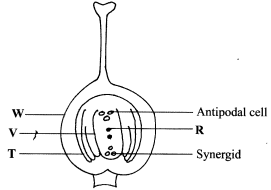
- Name the part labelled W. (1 mark)
- Describe what happens when the pollen tube enters the structure labelled V. (5 marks)
- What do structures labelled R and T develop into after fertilisation?
R (1 mark)
T (1 mark)
-
- What is meant by the term genetics? (1 mark)
- State two examples of discontinous variation. (2 marks)
- A female with a sickle cell trait marries a normal man. The allele for sickle cell is Hbs and the normal allel is HbA. Determine the probability that their first first born will have the sickle cell trait. Show your working. (5 marks)
- In an experiment to investigate a factor affecting photosynthesis, a potted plant which had been kept in the dark overnight was treated as shown in the diagram below and exposed to light.
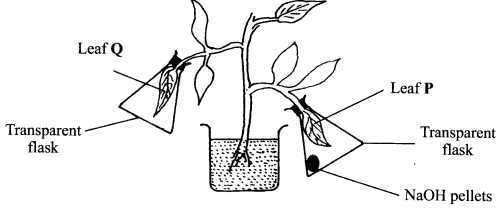
- Why was the potted plant kept in the dark overnight? (1 mark)
- Which factor as being investigated in the experiment? (1 mark)
-
- Which test did the students perform to confirm photosynthesis in the leaves labelled P and Q? (1 mark)
- State the results obtained in the leaves labelled P and Q.
P (1 mark)
Q (1 mark) - Explain the results obtained in leaves labelled P and Q.
P (1 mark)
Q (1 mark)
- What was the purpose of leaf Q in the experiment? (1 mark)
- In an experiment to investigate a plant response, the set up shown in the diagram below was used.
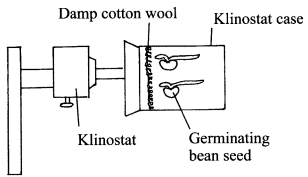
- Name the type of response that was being investigated. (1 mark)
- If the klinostat was not rotating:
- state the observations that would be made on the seedlings after three days; (2 marks)
- explain the observations in (b)(i) above. (3 marks)
- If the experiment was repeated with the Klinostat rotating:
- state one observation that was made on the seedlings after three days; (1 mark)
- give a reason for the observation made on the seedlings. (1 mark)
SECTION B. (40 marks)
Answer question 6 (compulsory) and either question 7 or 8 in the spaces provided after question 8.
- The graph below shows the relative numbers of three main species of organisms in a pond.
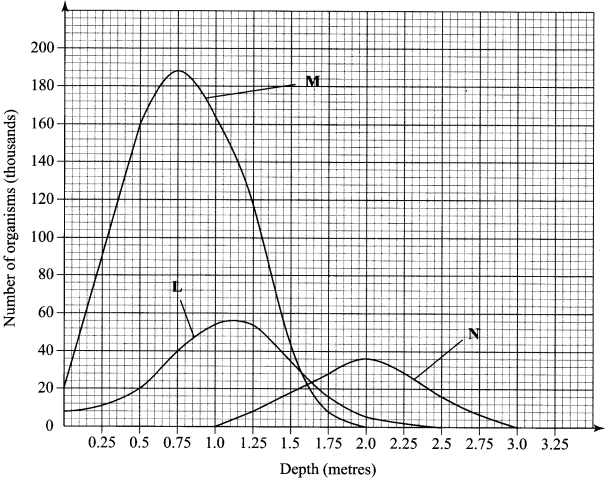
- Giving a reason for your answer, which one of the species is a
- Producer? (1 mark)
Reason (1 mark) - Secondary consumer? ( 1 mark)
Reason? (1 mark)
- Producer? (1 mark)
- State the depths at which each of the populations labelled L, M and N is at its optimum.
L (1 mark)
M (1 mark)
N (1 mark) -
- Which method may have been used to determine the population of organisms labelled N in the pond? (1 mark)
- Give a reson for your answer in (c) (i) above. (1 mark)
- State assumptions made when using the method in (c) (i) above. (4 marks)
- State two reasons why primary productivity in the pond decreases with depth. (2 marks)
- Explain the ecological importance of fungi to plants. (2 marks)
- Why is flooding likly to lead to cholera outbreak? (3 marks)
- Giving a reason for your answer, which one of the species is a
- Explain the various ways in which seeds and seeds are adapted to dispersal. (20 marks)
- How is the mammalian heart structurally adapted to its function? (20 marks)

MARKING SCHEME
SECTION A (40 marks)
-
- Alveolus; (1 mark)
- Y - oxygen/O;
Z - Carbon (IV) Oxide/CO; (2 marks) - Oxygen concentration is lower in the blood capillary than in the alveolus; oxygen diffuses; through the epithelium and endothelium of capillary wall, plasma into the red blood cells where it combines with haemoglobin. (3 marks)
- Cigarettes/tobacco contains tar; tar contains carcinogenic substances; which trigger cancer (2 marks)
-
- W - ovary wall/ovary; (1 mark)
- Tip of pollen tube bursts open; one of the nuclei fuses with the egg cell nucleus; to form a diploid zygote; while the remaining male nucleus fuses with the polar nuclei; to form a triploid endosperm nucleus; (5 marks)
- R - Endosperm/primary endosperm;
T - testa/seed coat; (2 marks)
-
- Branch of Biology that deals with the study of inheritance and variation. (1 mark)
-
- Sex;
- ABO blood group system/Rhesus factor;
- Ability to roll tongue;
- Free or attached earlobe;
- Presence/ absence of hair in the nosel on the ear pinna;
- Finger prints; ability to taste PTC (phenythiocarbamide) PTV (phenylthio urea)
- Winglength in prosophila; (viii) Size of abdomen in drosophila;
- Eye colour in prosophila; (x) Smooth/wrinkled seed coats in pea plants;
- Green/yellow seed coats/seed coat colour in pea plants;
- Polymorphism/melanic and non melanic forms in moths. (2 marks)

Complete punnet;Fertilization Male/Female HbA HbA HbA HbA HbA HbA F1 Genotypes Hbs HbA Hbs HbA Hbs
Probability of sickle cell trait (HB4 Hb)
= 2/4 = ½/0.5 / 50%; (5 marks)
-
- To destarch/remove starch from the leaves; (1 mark)
- Carbon (IV) Oxide/CO,;(1 mark)
-
- Test for starch; (1 mark)
- P - Retained the colour of iodine solution/brown/yellow; (1 mark)
Q - Turned blue-black/black/dark-blue;
(1 mark) - P - Did not photosynthesize /no startch is formed because Sodium Hydroxide pellets absorbed Carbon (IV) Oxide;
Q - Photosynthesized /starch was formed because Carbon (IV) Oxide was in the flask; (2 marks)
- Control (experiment); (1 mark)
-
- Geotropism/Gravitropism; (1 mark)
-
- The shoot tip/plumule curved upwards; root tip/radicle curved downwards; (2 marks)
- Auxins migrated downwards to lower side; Higher concentration on the lower side; caused more growth on the lower side than on the upper side in shoots/ inhibited growth on the lower side than on the upper side in the roots; (3 marks)
-
- The seedling will continue growing horizontally;
- There was even distribution of auxins (on the tips);
SECTION B (40 marks)
-
-
- Producer - M(1 mark)
Reason
Largest in number hence source of food for the other species/
Abundant on the water surface to trap light for photosynthesis; (1 mark) - Secondary consumer - N
Reason - Smaller in number than L and M (1 mark)
- Producer - M(1 mark)
- L - 1.125 m;
M - 0.75 m;
N - 2.00 m; (3 marks) -
- Capture - Recapture (method) /Capture - mark - release - recapture; (1 mark)
- Animals are highly mobile; (1 mark)
-
- No migration during the period of survey/study;
- No deaths/variation/reproduction in population during the period;
- Method of marking does not affect the animal behaviour;
- Marked/released animals will freely mix with others in the pond;
- Released/marked animals will have enough time to mix with the others;
- There is uniform/random distribution of animals within the period.(Max. 4 marks)
- Decrease in light intensity as depth increases;(1 mark)
Decrease in temperature as depth increases; (1 mark) - Breakdown of organic materials/decompose/rot/decay of materials; to release plant nutrients; (2 marks)
- Flood water may mix with human waste contaminated with cholera bacteria; The flood water may then contaminate food / water sources; The contaminated water/food causes cholera infection when ingested; (3 marks)
-
-
- Wind
- dispersed seeds / fruits are light / small to be carried by air currents;
- Some seeds / fruits have developed hairy structure feather-like projections; wing like structure which increase their surface area to be blown about /carried away by wind;
- open capsules; borne on long stalks, which are swayed by wind scattering seeds.
- Water
- dispersed fruits / seeds are also light; to float on water;
- Some, (like coconuts) have fibrous /spongy mesocarps to trap air; making them buoyant/ floating on water;
- Others (like the water lily) produce seeds whose seed coats trap air bubbles; making them float on water;
- Some have water-proof seed testa / pericarp; remain afloat without soaking / sinking immediately they are released from parent plants;
- Animal
- dispersed fruits have developed hooks; to stick on the fur of passing) animals;
- In some cases, fruits are succulent, brightly coloured / scented; to attract animals, birds;
- The seed coats (of some seeds) are hard; and resistant to the digestive enzymes; hence passing out through the gut undigested;
- Self dispersal by explosive mechanism;
- Fruits have sutures/lines of wakness; which split open when drying scaterring seeds.
Max = 20 marks
- Wind
-
- Has cardiac muscles, which contract and relax continuously/without fatigue;
- Cardiac muscles are interconnected/form a network of fibres; to rapidly and uniformly spread the contractions;
- Divided into four chambers; for the atria to receive blood and ventrical to pump blood out of the heart.
- Divided into two sides by a longitudinal septum; to prevent mixing of oxygenated and deoxygenated blood;
- Ventricles have thicker walls; to generate high pressure to pump blood;
- Wall of left ventricle are thicker than those of right ventricle; to pump blood over a longer distance;
- Has valves; to prevent back flow of blood for double circulation;
- Cuspid valves have strands of connective tissues/cordaetandinae/tendinous; to prevent the valves from turning inside out during systole when ventricles contract;
- Has coronary artery to nourish/supply oxygen/nutrients the heart muscles;
- Has coronary vein; to remove metabolic wastes;
- Enclosed by a pericardium; to keep it in position/prevent overdilation;
- Pericardium is externally surrounded with a layer of fats; to cushion the heart against mechanical damage;
- Pericardium secretes pericardial fluid; to reduce friction/absorb shock;
- Has Sino Atrio Node (SAN); which acts as a pace maker;
- Has Atrio Ventricular Node (AVN); which relays contraction waves from Sino Atrio Node to the purkinje tissue;
- Has purkinje tissue/bundle of HS; to relay waves from Atrio Ventricular Node; to the ventricular myocardium;
- Cardiac muscles have numerous mitochondria; to generate energy for the muscular contractions;
- Vena cava and pulmonary vein; supply blood to the heart;
- Aorta and pulmonary artery; transport blood away from the heart.
(max 20 marks)
Join our whatsapp group for latest updates
Tap Here to Download for 50/-
Get on WhatsApp for 50/-
Download KCSE 2015 Biology Paper 2 with Marking Scheme.
Tap Here to Download for 50/-
Get on WhatsApp for 50/-
Why download?
- ✔ To read offline at any time.
- ✔ To Print at your convenience
- ✔ Share Easily with Friends / Students

